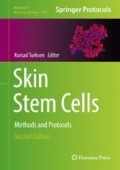Abstract
Stem cells that reside in the bulge of adult mouse hair follicles are a leading model of tissue stem cell research. Ex vivo culturing, molecular and cell biological characterizations, as well as genetic manipulation of fluorescence-activated cell sorting-isolated bulge stem cells offer a useful experimental pipeline to complement in vivo studies. Here we describe detailed methods for culturing, immunostaining, live cell imaging, and adenoviral infection of bulge stem cells for downstream applications such as in vitro clonal and in vivo patch assays.
Access this chapter
Tax calculation will be finalised at checkout
Purchases are for personal use only
References
Alonso L, Fuchs E (2006) The hair cycle. J Cell Sci 119(Pt 3):391–393
Hsu YC, Li L, Fuchs E (2014) Emerging interactions between skin stem cells and their niches. Nat Med 20(8):847–856
Ito M, Kizawa K, Hamada K, Cotsarelis G (2004) Hair follicle stem cells in the lower bulge form the secondary germ, a biochemically distinct but functionally equivalent progenitor cell population, at the termination of catagen. Differentiation 72(9-10):548–557
Rompolas P, Mesa KR, Greco V (2013) Spatial organization within a niche as a determinant of stem-cell fate. Nature 502(7472):513–518
Rompolas P et al (2012) Live imaging of stem cell and progeny behaviour in physiological hair-follicle regeneration. Nature 487(7408):496–499
Nowak JA, Fuchs E (2009) Isolation and culture of epithelial stem cells. Methods Mol Biol 482:215–232
Zheng Y, Hsieh JC, Escandon J, Cotsarelis G (2016) Isolation of mouse hair follicle bulge stem cells and their functional analysis in a reconstitution assay. Methods Mol Biol 1453:57–69
Blanpain C, Lowry WE, Geoghegan A, Polak L, Fuchs E (2004) Self-renewal, multipotency, and the existence of two cell populations within an epithelial stem cell niche. Cell 118(5):635–648
Adam RC et al (2015) Pioneer factors govern super-enhancer dynamics in stem cell plasticity and lineage choice. Nature 521(7552):366–370
Author information
Authors and Affiliations
Corresponding author
Editor information
Editors and Affiliations
Rights and permissions
Copyright information
© 2018 Springer Science+Business Media New York
About this protocol
Cite this protocol
Haensel, D., McNeil, M.A., Dai, X. (2018). Ex Vivo Imaging and Genetic Manipulation of Mouse Hair Follicle Bulge Stem Cells. In: Turksen, K. (eds) Skin Stem Cells. Methods in Molecular Biology, vol 1879. Humana Press, New York, NY. https://doi.org/10.1007/7651_2018_136
Download citation
DOI: https://doi.org/10.1007/7651_2018_136
Published:
Publisher Name: Humana Press, New York, NY
Print ISBN: 978-1-4939-8869-3
Online ISBN: 978-1-4939-8870-9
eBook Packages: Springer Protocols

